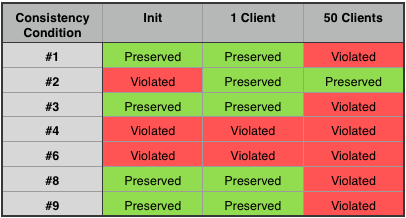Migration to NoSQL (3)
Published:
[Following the previous posts, here I am going to provide a detailed real-world example of the problems associated with the design of applications for NoSQL database]
Intro
TPC-C is a very well-known benchmark which covers various important properties of OLTP applications. The benchmark has been developed for many years before the introduction of NoSQL stores, and is clearly crafted to measure performance and correctness of traditional SQL stores. Consequently, it can be thought of as a perfect example of SQL-backed applications.
In order to support our ideas about the non-triviality of transferring SQL-backed applications to NoSQL versions, through a bit of googling, I was able to find a project by Andy Pavlo and others at CMU, implementing TPC-C using python for a variety of databases including Cassandra. As I expected, this was one of the very few examples implementing such applications for a NoSQL stores, because of all the difficulties associated with the task.
Running the project was fairly straight-forward (although I had to fix a few minor bugs to avoid failures during execution, I did not make any major change to either the code or the data-models). In the following section, I am going to present results of a series of tests (all codes available here) that I performed on this implementation regarding the correct behavior of the application. In these tests, I checked preservation of 7 (out of 12) consistency conditions, specified by the TPC-C benchmark to be preserved all the time in systems under test. The reason I omitted 5 of the conditions was only the complexity (as is mentioned in the TPC-C documentation) of running proper tests, although I expect similar results for them as well.
Results
The following results are taken on my laptop running Cassandra and the pytpcc implementation as it is offered. I checked the preservation of each consistency requirement at three different stages: before starting clients (DB containing only the initially loaded rows), after running a single client for 60 seconds and finally after running 50 concurrent clients for 60 seconds:

As we can see, almost all the conditions are violated in the multi-client setting and a few are not satisfied even in the initial and the single-client settings.
Example
Here I will explain in more detail the reason behind the incorrect behavior of the application using the consistency condition #1. The condition states that the year-to-date sales column of each warehouse must be equal to the combined sales from all of its districts, i.e. W_YTD=sum(D_YTD).
The following descriptions are taken from the official TPC-C documentation as a part of the “Payment “ transaction (here by transaction I simply mean the high-level sets of operations in the benchmark, e.g. delivery or new_order), which help clarify how the above columns are updated in the application:
- The row in the WAREHOUSE table with matching W_ID is selected. W_NAME, W_STREET_1, W_STREET_2, W_CITY, W_STATE, and W_ZIP are retrieved and W_YTD, the warehouse’s year-to-date balance, is increased by H_ AMOUNT.
- The row in the DISTRICT table with matching D_W_ID and D_ID is selected. D_NAME, D_STREET_1, D_STREET_2, D_CITY, D_STATE, and D_ZIP are retrieved and D_YTD, the district’s year-to-date balance, is increased by H_AMOUNT.
Clearly, both of above tasks are meant to be executed in low-level database (to some extent isolated) transactions. The developers however, do not address the problem of the lack of support for such transactions in Cassandra. As I have mentioned in the previous posts, such solutions are far from being trivial and no one addresses them. In this case (and most cases) developers simply accept the incorrect behavior by using batch insertions.
The following graph contains the result of a series of tests checking the first consistency condition and shows the trivial preservation of the consistency condition in the single-client and its violation in the multi-client setting. The error represents the (growing with the number of clients) difference between W_YDT and sum(D_YDT) which are required to be equal by the benchmark.

Conclusion
The above study presents test results, supporting our claim about non-triviality of transferring SQL-backed applications to the NoSQL world in a correct way: the lack of support for transactions in Cassandra is shown to result in incorrect behaviors in a real-world SQL-based application.
In this post, I only discussed the problems regarding application correctness, however, many more concerns about performance can be raised about the PyTPCC’s data-model as well. For example, the developers have performed no de-normalization and instead used secondary indices. Although they do not affect the correctness, secondary indices are generally considered performance and scalability killers in Cassandra applications which must be avoided at all costs (read more).
The combination of these problems forces the designers to settle for incorrect behaviors in exchange for performance. Now it is my goal to offer an automated tool that generates applications offering the best of both worlds - correctness of the SQL-backed applications and performance of NoSQL counterparts.
Leave a Comment